Functional microdomains in bacterial membranes
- PMID: 20713508
- PMCID: PMC2932971
- DOI: 10.1101/gad.1945010
Functional microdomains in bacterial membranes
Abstract
The membranes of eukaryotic cells harbor microdomains known as lipid rafts that contain a variety of signaling and transport proteins. Here we show that bacterial membranes contain microdomains functionally similar to those of eukaryotic cells. These membrane microdomains from diverse bacteria harbor homologs of Flotillin-1, a eukaryotic protein found exclusively in lipid rafts, along with proteins involved in signaling and transport. Inhibition of lipid raft formation through the action of zaragozic acid--a known inhibitor of squalene synthases--impaired biofilm formation and protein secretion but not cell viability. The orchestration of physiological processes in microdomains may be a more widespread feature of membranes than previously appreciated.
Figures
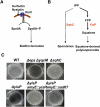
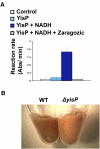
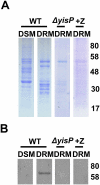


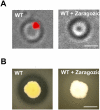
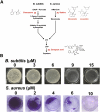
Comment in
-
Bacterial lipid rafts discovered.Nat Rev Microbiol. 2010 Nov;8(11):756. doi: 10.1038/nrmicro2455. Nat Rev Microbiol. 2010. PMID: 21080545 No abstract available.
Similar articles
-
Exploring the existence of lipid rafts in bacteria.Microbiol Mol Biol Rev. 2015 Mar;79(1):81-100. doi: 10.1128/MMBR.00036-14. Microbiol Mol Biol Rev. 2015. PMID: 25652542 Free PMC article.
-
Molecular composition of functional microdomains in bacterial membranes.Chem Phys Lipids. 2015 Nov;192:3-11. doi: 10.1016/j.chemphyslip.2015.08.015. Epub 2015 Aug 28. Chem Phys Lipids. 2015. PMID: 26320704 Review.
-
Functional Membrane Microdomains Organize Signaling Networks in Bacteria.J Membr Biol. 2017 Aug;250(4):367-378. doi: 10.1007/s00232-016-9923-0. Epub 2016 Aug 26. J Membr Biol. 2017. PMID: 27566471 Review.
-
The biofilm formation defect of a Bacillus subtilis flotillin-defective mutant involves the protease FtsH.Mol Microbiol. 2012 Oct;86(2):457-71. doi: 10.1111/j.1365-2958.2012.08205.x. Epub 2012 Aug 24. Mol Microbiol. 2012. PMID: 22882210 Free PMC article.
-
Spatio-temporal remodeling of functional membrane microdomains organizes the signaling networks of a bacterium.PLoS Genet. 2015 Apr 24;11(4):e1005140. doi: 10.1371/journal.pgen.1005140. eCollection 2015 Apr. PLoS Genet. 2015. PMID: 25909364 Free PMC article.
Cited by
-
Sticking together: building a biofilm the Bacillus subtilis way.Nat Rev Microbiol. 2013 Mar;11(3):157-68. doi: 10.1038/nrmicro2960. Epub 2013 Jan 28. Nat Rev Microbiol. 2013. PMID: 23353768 Free PMC article. Review.
-
Membranes are functionalized by a proteolipid code.BMC Biol. 2024 Feb 27;22(1):46. doi: 10.1186/s12915-024-01849-6. BMC Biol. 2024. PMID: 38414038 Free PMC article.
-
Cyanobacterial membrane dynamics in the light of eukaryotic principles.Biosci Rep. 2023 Feb 27;43(2):BSR20221269. doi: 10.1042/BSR20221269. Biosci Rep. 2023. PMID: 36602300 Free PMC article.
-
A cell wall synthase accelerates plasma membrane partitioning in mycobacteria.Elife. 2023 Sep 4;12:e81924. doi: 10.7554/eLife.81924. Elife. 2023. PMID: 37665120 Free PMC article.
-
Overproduction of flotillin influences cell differentiation and shape in Bacillus subtilis.mBio. 2013 Nov 12;4(6):e00719-13. doi: 10.1128/mBio.00719-13. mBio. 2013. PMID: 24222488 Free PMC article.
References
Publication types
MeSH terms
Substances
Grants and funding
LinkOut - more resources
Full Text Sources
Other Literature Sources
Molecular Biology Databases
